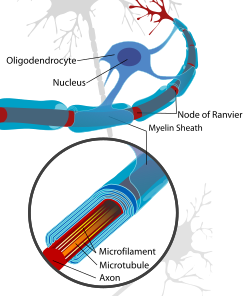| Oligodendrocyte | |
|---|---|
 Oligodendrocytes form the electrical insulation around the axons of CNS nerve cells. | |
| Details | |
| Location | Central nervous system |
| Identifiers | |
| Latin | oligodendrocytus |
| MeSH | D009836 |
| TH | H2.00.06.2.00003, H2.00.06.2.01018 |
| FMA | 83665 54540, 83665 |
| Anatomical terms of microanatomy | |
Oligodendrocytes (from Greek 'cells with a few branches'), also known as oligodendroglia, are a type of neuroglia whose main functions are to provide support and insulation to axons within the central nervous system (CNS) of jawed vertebrates. Their function is similar to that of Schwann cells, which perform the same task in the peripheral nervous system (PNS). Oligodendrocytes accomplish this by forming the myelin sheath around axons.[1] Unlike Schwann cells, a single oligodendrocyte can extend its processes to cover around 50 axons,[2] with each axon being wrapped in approximately 1 μm of myelin sheath. Furthermore, an oligodendrocyte can provide myelin segments for multiple adjacent axons.[1]
Oligodendrocytes are exclusively found in the CNS, which comprises the brain and spinal cord. It was once thought that these cells were produced in the ventral neural tube, the embryonic precursor to the CNS. However, recent research suggests that oligodendrocytes originate from the ventral ventricular zone of the embryonic spinal cord, with some potential concentrations in the forebrain.[3] Notably, oligodendrocytes are the last type of cell to be generated in the CNS.[4] Oligodendrocytes were discovered by Pío del Río Hortega.[5][6]
- ^ a b Carlson N (2010). Physiology of Behavior. Boston, MA: Allyn & Bacon. pp. 38–39. ISBN 978-0-205-66627-0.
- ^ Baumann N, Pham-Dinh D (April 2001). "Biology of oligodendrocyte and myelin in the mammalian central nervous system". Physiological Reviews. 81 (2): 871–927. doi:10.1152/physrev.2001.81.2.871. PMID 11274346.
- ^ Richardson WD, Kessaris N, Pringle N (January 2006). "Oligodendrocyte wars". Nature Reviews. Neuroscience. 7 (1): 11–18. doi:10.1038/nrn1826. PMC 6328010. PMID 16371946.
- ^ Thomas JL, Spassky N, Perez Villegas EM, Olivier C, Cobos I, Goujet-Zalc C, et al. (February 2000). "Spatiotemporal development of oligodendrocytes in the embryonic brain". Journal of Neuroscience Research. 59 (4): 471–476. doi:10.1002/(SICI)1097-4547(20000215)59:4<471::AID-JNR1>3.0.CO;2-3. PMID 10679785. S2CID 42473842.
- ^ Pérez-Cerdá F, Sánchez-Gómez MV, Matute C (2015). "Pío del Río Hortega and the discovery of the oligodendrocytes". Frontiers in Neuroanatomy. 9: 92. doi:10.3389/fnana.2015.00092. PMC 4493393. PMID 26217196.
- ^ James OG, Mehta AR, Behari M, Chandran S (June 2021). "Centenary of the oligodendrocyte". The Lancet. Neurology. 20 (6): 422. doi:10.1016/S1474-4422(21)00136-8. PMC 7610932. PMID 34022167.